Text
I feel like the MS Queen Victoria is a really underrated ship, and she deserves more love and attention.
9 notes
·
View notes
Text
RMS Olympic entering New York Harbor after sinking the lightship Nantucket, May 16, 1934.
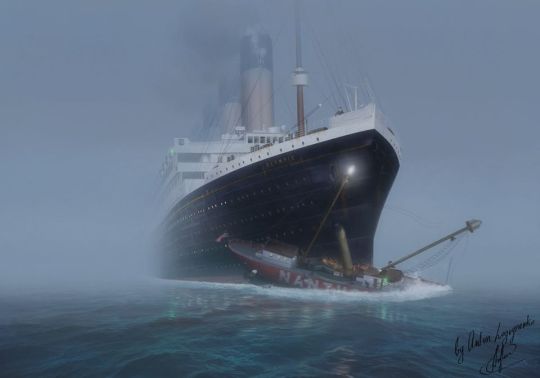
“May 15, 1934 at 10.55 am RMS Olympic was on her way to New York City, trying to determine an exact position of the US lightship LV-177 (known as Nantucket) in the fog. Visibility was 150 meters, just 2/3 of the Olympic’s huge hull. It appeared that Olympic was well clear of the lightship, but a few minutes later the lookout spotted LV-117 dead ahead. Captain Binks was trying to avoid collision by ordering the ship’s rudder to be set full to port and the engines to be set full speed astern. But it was too late and at 11.06 am she collided with the side of the lightship. Although she was moving just 3 kn (5.6 km/h), her sheer weight, and thus her kinetic energy, completely wrecked the smaller vessel.”
Source
University of South Carolina: MVTN_22-69_Mez1_CMS_456_Acc
#rms olympic#history#ocean liners#white star line#lightship nantucket#new york#nyc#new york city#new york harbor
119 notes
·
View notes
Text
Ladies and gentlemen, I have forgotten ANOTHER important thing that happened on you guessed it...
September 20th.
So hopefully this is the last important thing that happened on September 20th that I will need to make a post about.
On September 20th, 1906, White Star Line's RMS Adriatic was launched at Harland and Wolff in Belfast, Ireland. The launch of the Adriatic took place on the exact same day as the launch of Cunard's Mauretania.
The Adriatic's maiden voyage took place on May 8th, 1907. She was the last ship built of White Star Line's Big Four, and she was the most luxurious and large out of the 4 liners. She had a long and successful career along with her sisters Celtic, Cedric, and Baltic. She was scrapped in 1935.
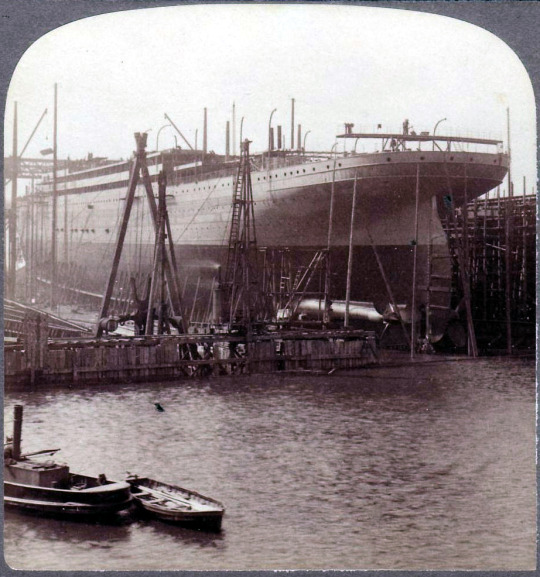
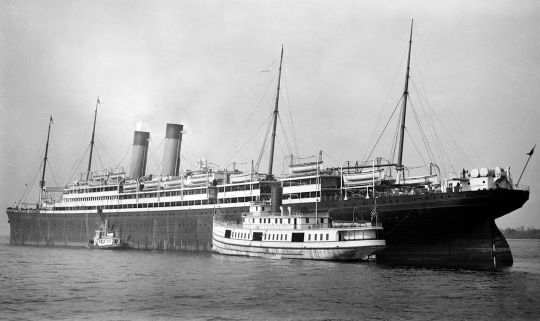

21 notes
·
View notes
Text
Well, with all the excitement of the Mauretania's launch anniversary and the Olympic-Hawke collision anniversary, I forgot about the anniversary of the launching of the Queen Elizabeth 2, which also happened to take place on September 20th.
Although today is not September 20th, it has been 54 years since the launch of the QE2 in Clydebank, Scotland. She was constructed in the same slipway as the Lusitania, Aquitania, Queen Mary, and Queen Elizabeth. Her maiden voyage took place on May 2nd, 1969. She enjoyed a very long career of 39 years. She was retired in November 2008, and now resides in Dubai as a floating hotel.
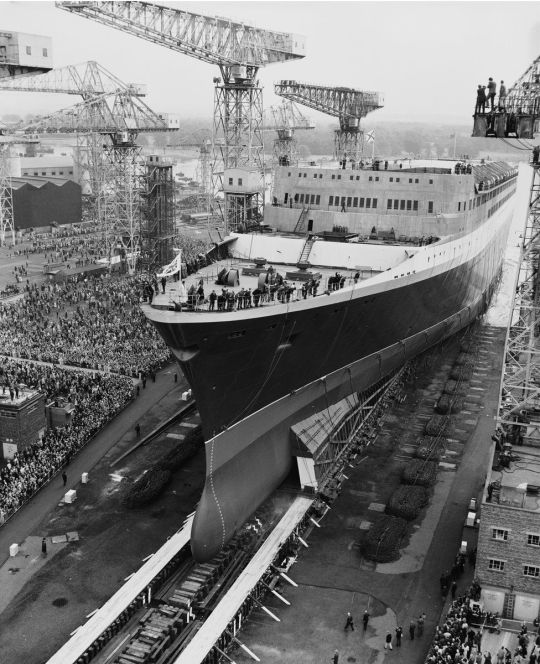



20 notes
·
View notes
Text
On this day 87 years ago, the RMS Queen Mary was launched in Clydebank, Scotland. Her career began on May 27th, 1936, and she retired in December 1967. She was known for her astounding size and incredible speed throughout her 31 year long career. She was a holder of the Blue Riband, and after a long battle for it with against the Normandie, she captured it in 1938 with an astonishing 30.99 knots. She held the record until 1952, when the SS United States entered service.
She served as a troopship during the second world war, carrying up to 11,000 souls at a time. She was hit by a 28 meter Rouge wave in 1942, with 11,339 people on board at the time. She was inches away from capsizing. The Queen Mary survived the war, and continued a successful career throughout the 1950s and 1960s. It was decided to retire her in 1967, and she was bought by the city of Long Beach to serve as a floating hotel. She is still docked there to this day.
Long live the Queen.

12 notes
·
View notes
Photo

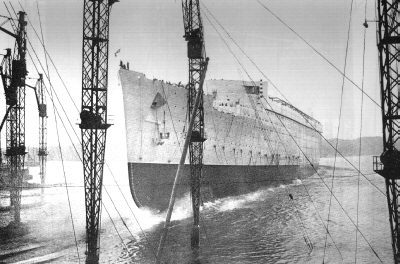

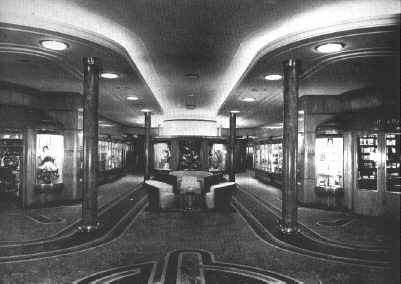


On September 26th 1934 the Liner Queen Mary launched at John Brown’s shipyard, Clydebank.
The construction of still the unnamed Cunard Queen Mary ship began in December 1930 (the ship’s keel was laid down on 31 January 1931) in the yard of “John Brown & Co” at Clydebank. The launch was scheduled for May 1932, but the work on the ship was suspended in December 1931 due to the world economic depression. A loan of 9.5 million pounds from the Government was granted to the Cunard Line with enough money to complete the Queen Mary ship and to build a second liner – the Queen Elizabeth.
As a direct result of this most advantageous deal, the Cunard Line merged with its main rival White Star on 10th May 1934 into Cunard White Star Ltd. The Queen Mary construction resumed in April 1934, the liner was completed by August and launched on 26th September at a total cost of 3.5 million pounds sterling.
The work was completed in March 1936. The Queen Mary ship sailed out for preliminary trials and after being painted in Southampton, the liner was handed over to Cunard White Star Line on 11th May 1936. RMS Queen Mary ship first sailing was on 14th May with its Transatlantic itinerary being Southampton-Cherbourg-New York. By May 1937 the liner had carried a total of almost 57,000 passengers.
The main speed-rival of the QM ship was SS Normandie – a liner built in France and operated by the French Compagnie Generale Transatlantique line. The Queen Mary took the Blue Riband (the prestigeous award given to a ship with the speed record for a transatlantic crossing) from the French liner SS Normandie in August 1938, with record speeds for both west- and eastbound crossings of the Atlantic Ocean – the average speeds was, respectively, 30,63 kn (35m25 mph, 56,7 km/h) and 30,14 kn (34,68 mph, 55,82 km/h).
In 1937, the Normandie liner was refitted with new propellers, enabling her to take the Blue Riband, but in 1938 the Queen Mary ship reclaim the honour for best speeds in both directions – westbound 30,99 kn (35,66 mph, 57.39 km/h) and eastbound 31,69 kn (36,47 mph, 58.69 km/h). This record was beaten by the SS United Sates liner in 1952.
The last commercial sailing of the ship Queen Mary was on 30 August 1939 departing from Southampton and then berthed at New York until the end of 1939. With the outbreak of the Second World War, she was converted into a troopship and ferried Allied soldiers for the duration of the war.
Following the war, Queen Mary was refitted for passenger service and along with Queen Elizabeth commenced the two-ship transatlantic passenger service for which the two ships were initially built. The two ships dominated the transatlantic passenger transportation market until the dawn of the jet age in the late 1950s. By the mid-1960s, Queen Mary was ageing and, though still among the most popular transatlantic liners, was operating at a loss.
After several years of decreased profits for Cunard Line, Queen Mary was officially retired from service in 1967. She left Southampton for the last time on 31 October 1967 and sailed to the port of Long Beach, California, United States, where she remains permanently moored. Much of the machinery, including one of the two engine rooms, three of the four propellers, and all of the boilers, were removed. The ship serves as a tourist attraction featuring restaurants, a museum and a hotel. The ship is listed on the National Register of Historic Places. The National Trust for Historic Preservation has accepted the Queen Mary as part of the Historic Hotels of America.
RMS Queen Mary remains in Long Beach but recently it has been reported it is in need of significant repairs according to assessments and photos in 2019 and 2020. An estimated $289 million in repairs are needed after years of decline and the most recent operator going bankrupt.But even to “retire and recycle” the liner could cost up to $190m.
It has been mooted that it could return to the Clyde.
70 notes
·
View notes
Photo
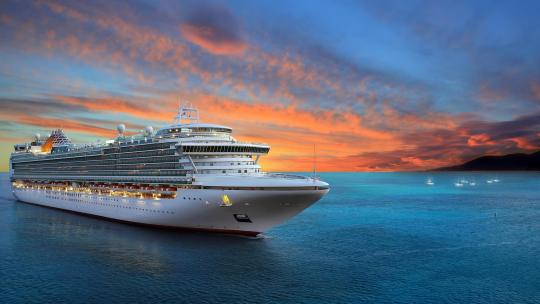
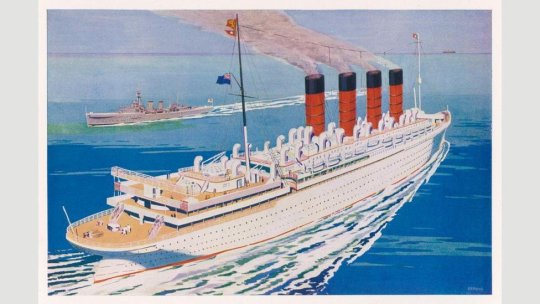




The Lusitania, shown here on its arrival to New York City in 1907, was one of the ships which launched the modern era of leisure cruising
The Monster Ships That Changed How We Travel
The beauty salons, swimming pools and even wireless communications of today’s huge cruise ships all got their start with the “floating palaces” of a century ago.
BBC FutureKat Long
When the world’s then-largest ocean liner embarked on its first transatlantic voyage in September 1907, thousands of spectators gathered at the docks of Liverpool to watch. “She presented an impressive picture as she left, with her mighty funnels and brilliant illumination,” wrote one reporter. Cunard’s RMS Lusitania had been outfitted with a new type of engine that differed from that of its rivals – and would go on to break the speed record for the fastest ocean crossing not once, but twice.
Between 1850 and 1900, three British passenger lines – Cunard, Inman and White Star – dominated transatlantic travel. Toward the end of the century, as increasing numbers of emigrants sought passage to the US and a growing class of Gilded Age travellers demanded speed and luxury, corporate rivalry intensified. Pressure from other European lines forced the British companies to add amenities like swimming pools and restaurants.
Not unlike today’s rivalries between, say, aircraft manufacturers like Airbus and Boeing, each raced to make its ocean liners the largest, fastest and most opulent. In the process, they launched the modern age of leisure cruising – and developed innovations and technologies that continue to be used on cruise ships today.
Comfort Class
In the mid-19th Century, there were two main players. Inman’s inaugural steamship, launched in 1850, made it the first major British line to replace traditional side-mounted paddlewheels with a screw propeller – an apparatus with fixed blades turning on a central axis. With the added speed and fuel efficiency this brought, plus a sleek iron hull that was more durable than wood, Inman established itself as a company unafraid to try new technology for faster crossings.
‘For safety and comfort, take the old reliable Cunard Line’, reads this advertisement from around 1875. Credit: Alamy.
Inman’s main rival, Cunard, focused on safety instead. “The Cunard way was to let competitors introduce new-fangled technology and let them deal with the setbacks,” says Michael Gallagher, Cunard’s company historian. “Once that technology had proved itself, only then would Cunard consider using it.”
But Cunard risked being left behind both by Inman and by a new rival which burst onto the scene in 1870 – the White Star line’s splashy debut included five huge ocean liners, dubbed “floating hotels”. Their flagship, RMS Oceanic, launched in 1871 and had efficient compound engines that burned just 58 tonnes of coal per day, compared with 110 tonnes consumed by Inman’s ships. That gave White Star the budget to invest in comfort.
The contrast with Cunard was stark. “Where Oceanic had bathtubs, Cunard offered a basin; where Oceanic had central heating, Cunard offered stoves; and where Oceanic had lavatories, Cunard managed with chamber pots,” says Gallagher. Architects for Oceanic also moved first-class cabins to mid-ship for less rocking on the waves.
In the 1880s and 1890s, each of White Star’s new ships captured the Blue Riband, an unofficial accolade which recognises the passenger liner able to make the fastest average speed on a westbound Atlantic crossing. In answer, Inman built SS City of New York and SS City of Paris. The City of Paris won the Blue Riband several times thanks to its expensive but fuel-efficient triple-expansion engines and twin screw propellers. The innovation was a first for an ocean liner, and meant that if one propeller broke, the other could compensate – finally ending the need for auxiliary sails. This suddenly freed up a lot more space on deck that would later be put to good use by providing luxury facilities for their passengers.
In 1888, Inman introduced ships which no longer required auxiliary sails, giving ocean liners a similar look to the one they have today. Credit: Alamy.
Cunard, meanwhile, ventured into the new world of telecommunications by installing the first Marconi wireless stations, which allowed radio operators to transmit messages at sea, on its sister ships RMS Lucania and RMS Campania. First-class passengers could even book European hotels by wireless before reaching port.
“Connectivity was just as important to passengers in the past as it is today,” says William Roka, historian and public programmes manager at South Street Seaport Museum in New York City.
In 1897, Germany entered the fray. Shipping company Norddeutscher Lloyd unveiled its colossal Kaiser Wilhelm der Grosse – which shocked its rivals by taking the Blue Riband from Britain after 52 years. Another German liner, the SS Amerika, wowed its well-heeled guests by introducing the first à la carte restaurant at sea: the Ritz-Carlton, brainchild of Paris hotelier Cesar Ritz and renowned chef Auguste Escoffier. It allowed guests to order meals at their leisure and dine with their friends rather than attend rigidly scheduled seatings – a forerunner of the kind of freestyle dining seen on today’s cruise ships.
The freestyle dining seen on today’s cruise ships dates back to 1905. Credit: Alamy.
To complicate matters, American banking tycoon JP Morgan was buying up smaller companies to create a US-based shipping-and-railroad monopoly. In 1901, White Star became his biggest acquisition. Inman, too, now was US-owned, having been bought by an American company in 1893. Suddenly, the battles weren’t only in the boardrooms: building the world’s top ocean liners was now a point of national pride.
With the help of a £2.6 million government loan (equivalent to more than £261 million today), Britain’s Cunard line launched the massive twins RMS Lusitania and RMS Mauretania. Both had the first steam turbine engines of any superliner. To reach its sustained speed of 25 knots (46.25 km/h), the Lusitania had “68 additional furnaces, six more boilers, 52,000 sq ft of heating surface, and an increase of 30,000 horsepower,” reported the New York Times. “If turbines had not been employed, at least three 20,000-horsepower engines would have been necessary.”
White Star fought back with RMS Olympic, RMS Titanic and HMHS Britannic. Like the Lusitania and Mauretania, White Star’s trio would feature double hulls and watertight bulkheads. With standard reciprocating engines, they were slower than the Cunarders, but surpassed them in size and elegance. The Olympic and another White Star liner, the Adriatic, even debuted the first indoor swimming pools at sea. A first-class passenger “may indulge in Turkish and electric baths, take recreation in the gymnasium or [with] a squash racket or divert himself in the swimming pond,” marvelled one newspaper.
“It was fun for the first-class passengers to send postcards back home saying, ‘Writing to you from the deck of the world’s biggest ship, wish you were here,’” says historian William H Miller Jr.
First introduced on ocean liners more than 100 years ago, gymnasiums – shown here on Cunard’s Berengaria around 1930 – remain a staple of cruise ships today. Credit: Alamy.
History changed course when Titanic hit an iceberg on 14 April 1912 and sank on her first transatlantic voyage. As a result of the tragedy, safety regulations were updated to require lifeboat berths for every passenger and 24-hour radio surveillance (rules which are still in place).
But there were more challenges to come. World War One broke out in 1914 and European governments requisitioned liners for war service. Then a German submarine torpedoed Lusitania off the coast of Ireland on 7 May 1915, killing more than a thousand of those on board.
Cruising On
Despite a post-war liner-building boom, US anti-immigration laws reduced the number of transatlantic emigrants – the liners’ bread and butter – in the 1920s.
“Ships only made money when there were passengers aboard,” says David Perry, a maritime historian. “The companies needed to do something to stay afloat, so they created the tourists.”
Cunard modernised the aging Mauretania to burn oil instead of coal (most liners were converted to burn oil after World War One), painted its dark hull white to reflect the sunlight and sent her to the tropics as the first cruise ship catering to the new class of passengers: US vacationers who wanted a holiday at sea, replete with the nostalgic glamour of yesteryear. “Cruising offered a way for steamship companies to keep using their older transatlantic vessels and [make] additional revenue,” says Roka.
Cunard modernised the Mauretania and gave it a white hull, as shown in this 1930s illustration. Credit: Alamy.
After the Depression forced a struggling Cunard and White Star to merge, the new Cunard-White Star built the immense RMS Queen Mary and RMS Queen Elizabeth. To compete with German, American and French liners, designers ratcheted up the creature comforts, like air-conditioning and private bathrooms in every stateroom. The Italian liners Conte de Savoia and Rex featured the first outdoor swimming pools “with real sand around them to make it look beachy – completely over the top,” Perry says. By 1957, more people crossed the Atlantic by ship than ever before.
But by the following year, jet passengers outnumbered them.
“Cunard said flying was a fad,” Miller says. “But if, like the company slogan said, ‘Getting there is half the fun’, then getting there faster was a lot more fun.”
Despite Cunard’s best efforts, by the late 1950s more people were flying than taking ships to their destinations. Credit: Alamy.
Air travel and high operating costs doomed most transatlantic liners by the 1970s – only Cunard’s RMS Queen Mary 2 makes regular transatlantic crossings now.
Even so, cruising itself grew more popular over the ensuing decades. And not only does the idea of leisure cruising stem from these early days of competition, but so do many of the specific features of today’s massive ships.
Today’s vessels still feature oil-burning engines, though the power and propulsion systems are much more sophisticated. Modern perks like barbershops and beauty salons, freestyle dining, pools and libraries all were introduced on the original “floating palaces.” Even internet communication has its roots in the wireless rooms aboard the great ocean liners.
But the most important similarity may be the most basic.
“The feeling of the deck under your feet is the same,” says Perry. “That’s the transformative power of a voyage at sea.”
https://getpocket.com/explore/item/the-monster-ships-that-changed-how-we-travel
More Stories from Pocket
How to Fly the Best First-Class Seats, Cheaper Than Economy
The Deadliest Disaster at Sea Killed Thousands, Yet Its Story Is Little-Known. Why?
Why Bigger Planes Mean Cramped Quarters
The Quest to Find—and Save—the World’s Most Famous Shipwreck
Aboard the Giant Sand-Sucking Ships That China Uses to Reshape the World
7 notes
·
View notes
Text

Me watching the video of the goodbye for the Olympic and Mauretania. I've been avoiding that video for YEARS and turns out someone put it on another video about those ships. I'm feeling really blue rn--
I don't know why I love them so much 😭
23 notes
·
View notes
Text
So for some reason, Tumblr won't let people ask questions anonymously on this blog. So if you send in an ask, it won't be anonymous.
3 notes
·
View notes
Text

ship shipping for fun and profit
49 notes
·
View notes
Text
On this day 115 years ago, the RMS Mauretania was launched. At the time, she was the largest ship in the world until the completion of the RMS Olympic in 1910. She captured the Blue Riband in 1909 and held it for the next 20 years. She served as both a troopship and a hospital ship in the first world war, and enjoyed a successful career throughout the 1920s. She was sold for scrap in 1935.

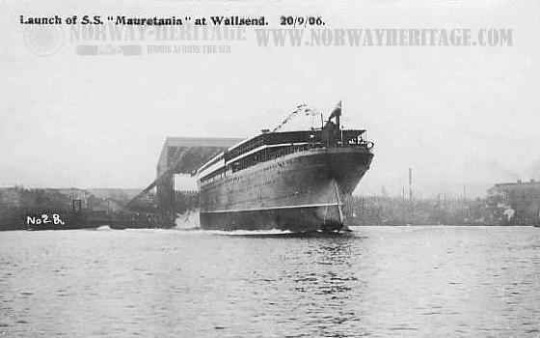



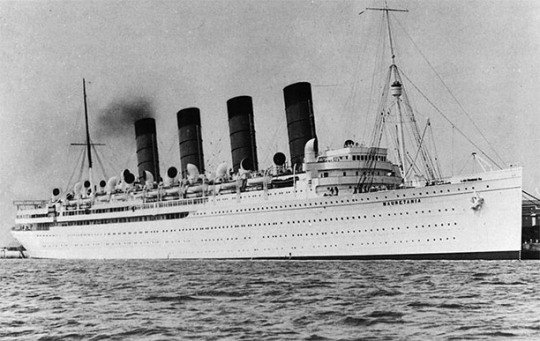
32 notes
·
View notes
Text
Today marks a very important day in Maritime history. 110 years ago today, the RMS Olympic collided with the British naval cruiser HMS Hawke. The HMS Hawke tore two massive holes in the Olympic's stern on the starboard side, causing 2 of her watertight compartments to flood, and also twisting her propeller shaft. The Hawke's bow was severely damaged, and the ship almost capsized. The Olympic managed to sail back to Southhampton under her own power, and was temporarily repaired to sail to Belfast for permanent repairs. She returned to service in November 1911.

17 notes
·
View notes
Text
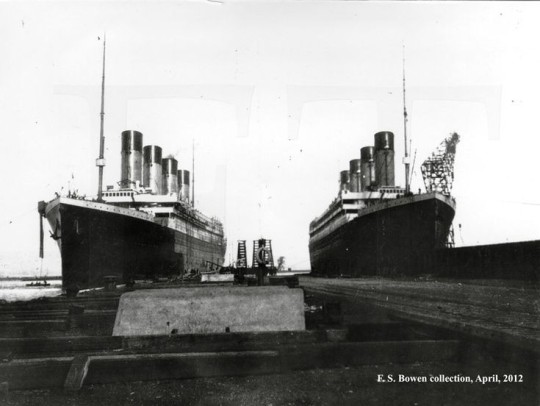
RMS Olympic and RMS Titanic
91 notes
·
View notes
Text
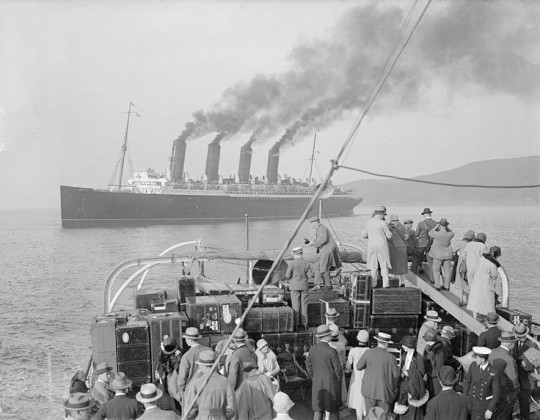



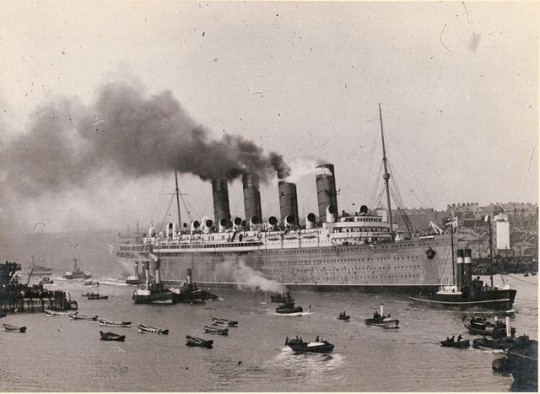

RMS Mauretania (1906)
41 notes
·
View notes
Text
honestly if you ever watch Titanic with me prepare yourself because you’re not going to be watching a movie
you’re getting a history lesson.
22 notes
·
View notes
Text
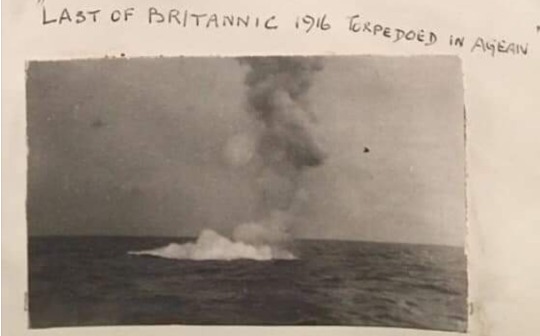
This photo is believed to be the last photo ever taken of the HMHS Britannic.
24 notes
·
View notes
